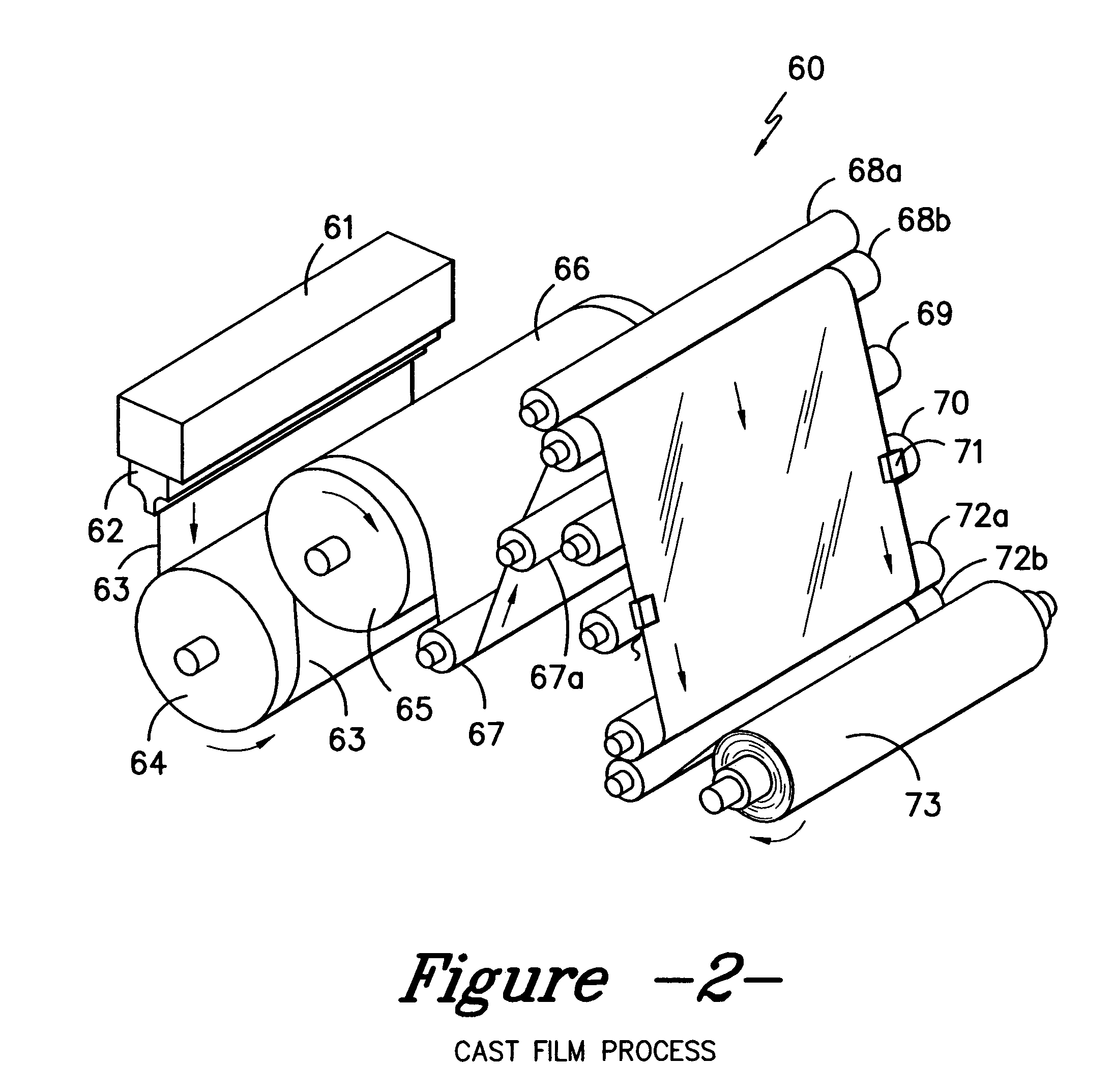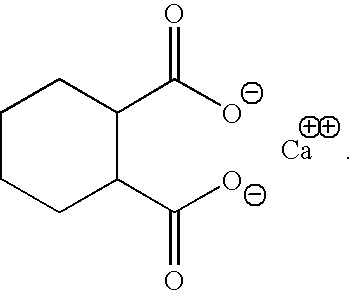Film and methods of making film
a technology of film and film, applied in the field of film and method of filmmaking, can solve the problems of not being able to predict the success of using the same formula in another type of processing technique,
- Summary
- Abstract
- Description
- Claims
- Application Information
AI Technical Summary
Problems solved by technology
Method used
Image
Examples
example 1
Calcium HHPA in LLDPE
[0042] To a common Linear Low Density Polyethylene (LLDPE) in the film industry and having a density of 0.917 grams per cubic centimeter, a mixture of 1000 ppm of the following Calcium HHPA compound was applied:
[0043] The above compound and a standard stabilization package (500 ppm Irganox® 1010, 1000 ppm Irgafos 168, and 800 ppm zinc stearate) were also added to the formulation. The resulting mixture was physically blended, twin screw compounded, and pelletized. The resultant compounded resin was then made into film of 25 micron in thickness using a standard blown film process with a blow up ratio of 2.5. The resultant film had the following properties:
TABLE IPhysical Properties of LLDPE Blown FilmYieldBreak1% SecantDartStressStress% Elongation @ModulusElmendorfImpactSample(psi)(psi)Break(psi)Tear (g)(g)ASTMD882D882D882D882D1922D1709MethodControl1523 / 15232858 / 2336526 / 57919.9 / 23.7373 / 547340Clarified1610 / 17412727 / 3003480 / 66424.1 / 30.5246 / 490192
[0044] Values a...
example 2
CALCIUM HHPA in MDPE
[0045] To, a common MDPE in the film industry, having a density of 0.934 grams per cubic centimeter, a mixture of 1000 ppm of Calcium HHPA and a standard stabilization package (500 ppm Irganox® 1010, 1000 ppm Irgafos 168, and 800 ppm zinc stearate) were added. The resulting mixture was physically blended, twin screw compounded, and pelletized. The compounded resin was then formed into film of 25 micron in thickness using a standard blown film process with a blow up ratio about 2.5.
[0046] The resultant film had the following properties:
TABLE IIIPhysical Properties of MDPE Blown FilmYieldBreak%1%StressStressElongationSecantElmendorfDart ImpactSample(psi)(psi)@ BreakModulusTear (g)(g)ASTM MethodD882D882D882D882D1922D1709Control2394 / 24663580 / 3027476 / 58945.2 / 48.343 / 33176Clarified2481 / 27713246 / 2690404 / 53448.4 / 61.727 / 338
[0047] Values are Given as Machine Direction / Transverse Direction
TABLE IVOptical Properties of MDPE Blown FilmSample% Haze60° GlossControl18.150Cl...
example 3
CALCIUM HHPA in Various Types of Polyethylene
[0048] To several types of polyethylene (PEs), a mixture of 1000 ppm of Calcium HHPA and a standard stabilization package (500 ppm Irganox® 1010, 1000 ppm Irgafos® 168, and 800 ppm zinc stearate) were added. The resulting mixtures were physically blended, single screw compounded, and pelletized. The resultant compounded resin was then made into film of approximately 50 micron in thickness using a standard blown film process with a blow up ratio of approximately 2.0. The resultant films had the following optical properties:
TABLE VOptical Properties of PE Having Different Comonomer Typesand CatalystsResin DensityClarified %Resin(g / cc)Control % HazeHazeLLDPE #10.91823.611.6LLDPE #20.91723.711.5LLDPE #30.92025.79.5LLDPE #40.92025.410.6
PUM
| Property | Measurement | Unit |
|---|---|---|
| density | aaaaa | aaaaa |
| thickness | aaaaa | aaaaa |
| thickness | aaaaa | aaaaa |
Abstract
Description
Claims
Application Information
 Login to View More
Login to View More - R&D
- Intellectual Property
- Life Sciences
- Materials
- Tech Scout
- Unparalleled Data Quality
- Higher Quality Content
- 60% Fewer Hallucinations
Browse by: Latest US Patents, China's latest patents, Technical Efficacy Thesaurus, Application Domain, Technology Topic, Popular Technical Reports.
© 2025 PatSnap. All rights reserved.Legal|Privacy policy|Modern Slavery Act Transparency Statement|Sitemap|About US| Contact US: help@patsnap.com



